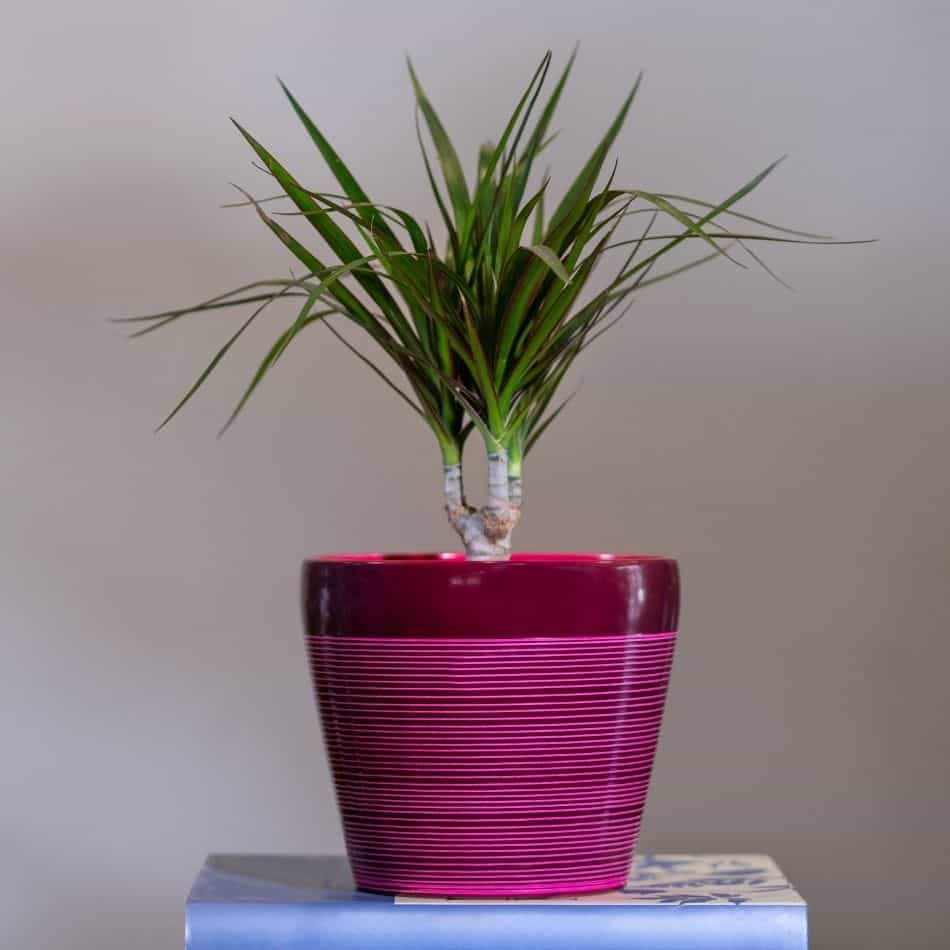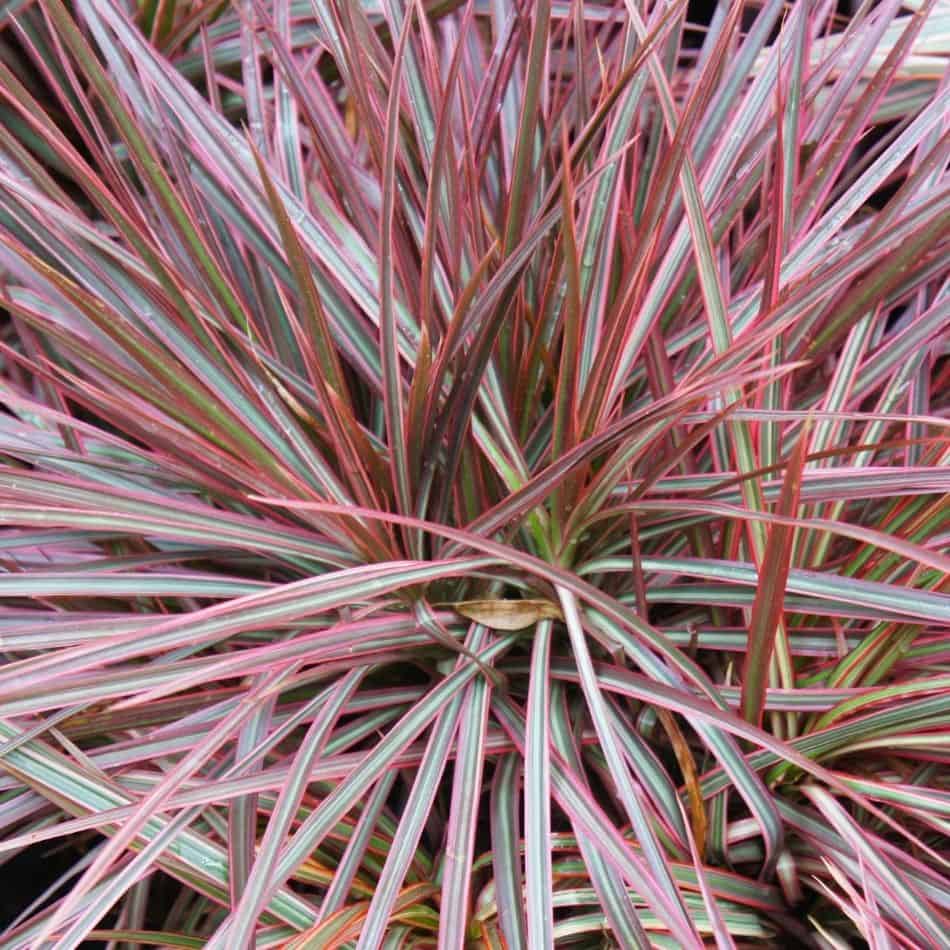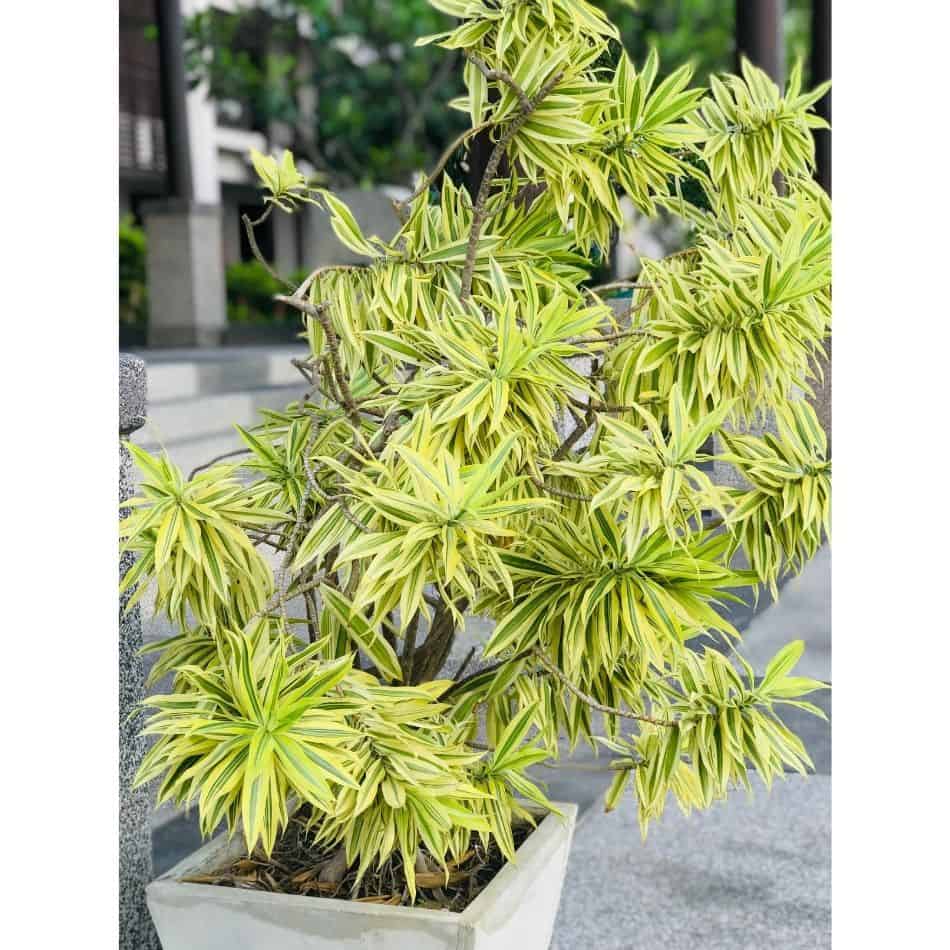Few houseplants are widely popular and common as Dracaena, the plant from the Agavaceae family, better known as Dragon Tree Plants. These tree-like species are well-liked houseplants, often seen not only in houses but in the offices, banks, or hotel lobbies.
Wherever it is placed, Dracaena will find a way to adapt, tolerating even the inhospitable conditions such are dry air, infrequent watering or lack of light, and generally minimal care!
These are great beginner friendly plants so you likely have a Dracaena if you have a tree like house plant.
Plant Profile
Dracaena is a genus of 120 plant species native to tropical and subtropical Africa. These long-living plants are evergreen perennials with a branched root system accustomed to a dry climate.
Dragon Trees are recognizable by a flat woody stem ending in several leaves rosettes. The leaves are narrow, pointed at the top, one foot or more long, green with a discrete red border.
All Dracaena are flowering plants that bloom in spring. However, when growing indoors, Dracaena rarely bloom. The white fragrant flowers have five petals, and the fruits are yellow-orange berries.
In nature, Dracaena are large plants that can grow up to 50 feet in height! The cultivars grown as a houseplant can reach up to 10 feet. Thankfully Dracaena grow slowly with 3-4 inches of new growth per year.
Varieties: Common Types of Dracaena
From the middle of the 19th century, when the first Dracaena were grown as houseplants, many cultivars have been created.
Nowadays, you can find Dracaena with narrow or broad leaves, light, dark, variegated, “colored,” tall, low, dense, sparse, and so on. Here are some of the most popular varieties from this colorful world:
Dracaena Draco

Dracaena Draco is most commonly called the Dragon Tree or Dragon’s Blood Plant and is the most famous representative of the species. Dracaena Draco is a succulent with a straight and upright trunk, and the palm-like canopy consists 1.5 inch wide leaves that are sharp similar to tiny blades. The leaves can be monochromatic or longitudinally striped greenish-white depending on the variety. The name dragon’s blood comes from the reddish resin that the plant excretes from wounds and nicks.
Dracaena Marginata

The popular variety, Dracaena Marginata, comes from Madagascar and has a slender stem with branched long, narrow leaves growing in dense tufts. The leaves can be monochromatic, but more popular is a bicolor variety with green-white stripes or even tricolor with a magnificent cream, green and pinkish-red pattern.
Dracaena Reflexa

Unlike other species, Dracena Reflexa is popular because of its irregular stem. It originates from the islands of the eastern part of the Indian Ocean what explains its common name – Song of India. It’s green leaves with conspicuous yellow edges are spirally arranged on the stem and tufted at the ends of branches.
How To Care For Dragon Tree Plants
Dracaena is one of the easiest plants to grow indoors. Dragon tree plants need bright indirect sunlight, warm temperatures, and infrequent watering. These plants are hardy plants making them beginner-friendly so they can withstand a bit of neglect.
Watering: Is Dracaena Ever Thirsty?
The basis of care for this plant begins with proper watering or rather infrequent watering.
Resistant to many challenges of indoor growing, the only issue the plant can not stand is excess soil moisture. In other words, water a Dragon Tree only when the substrate is almost completely dry, which is usually every 10 to 14 days in Spring and about once a month during Winter.
Since dracaena does not tolerate a large proportion of limescale, avoid the tap water and use soft and stagnant water if possible.
How Much Water Does Dracaena Need?
Not only can watering this plant too often can cause issues, but also watering this plant too heavily can be problematic.
Immersing the plant with a large amount of water after long periods of drought generally has a negative effect on this plant. So keep in mind that the required amount of water depends on the plant height.
As a rule of thumb, Dracaena’s that are about 1.5 feet tall need about a cup of water each time.
Here’s a general table that outlines how much water a Dracaena should receive per water cycle based on the plant’s height:
| Plant Height | Cups of Water |
|---|---|
| 1.5 feet | 1 cup |
| 3 feet | 2 cups |
| 4.5 feet | 3 cups |
| 6 feet | 4 cups |
Fertilization: Does Dracaena Need Additional Feeding?
Dracaena does not have a great need for fertilizer, but it can encourage growth.
You could add a diluted liquid fertilizer for deciduous plants once a month when watering the plant, from spring to autumn. Additional supplementation is beneficial when you have a large plant that you did not transplant into a fresh substrate at the beginning of the season.
During the winter, stop feeding your Dracaena since it can lead to root rot.
Soil: Is Dracaena Picky About The Substrate?
Dracaena is not particularly picky about the substrate as long as it is light and dries quickly after watering. Light, airy soil will help provide adequate air access for the plant’s roots.
In well-equipped garden centers, you can get a ready-made substrate for dracaena consisting of peat moss, sand, and coconut fiber. If you can not get such soil, make a mixture of ordinary garden soil with coarse sand or standard pot substrate mixed with perlite or sand in equal proportions.
Humidity: Is It Risky To Mist Dracena?
Dracena does not like moist soil but prefers a humid environment. It is a very adaptable plant that will thrive even in a dry air environment but will benefit from occasionally misting the leaves, especially in winter when heating dries the air.
However, do not mist or spray the leaves too often since too much moisture can lead to moisture accumulation in the leaf rosette, which can damage the plant. So allow the leaves to thorougly dry out in between mistings.
Light: Where To Place The Dragon Tree Plant?
This plant is best suited to well-lit places, out of direct sunlight as too much direct sunlight can burn its leaves. Although the plant can tolerate shaded positions, the lack of light will cause the leaves to fade, and in variegated species, the pattern may vanish.
The best places to place a Dragon Tree Plant indoors in near a North, West, or East facing window. South facing windows typically receive more direct sunlight so place the plant three to five feet away from these brighter windows.
Temperature: Is Dracaena A Warmth-loving Plant?
Like all plants of similar origin, dracaena does not tolerate low temperatures.
It thrives best in a space that has a uniform temperature in the range of 65°F to 85°F. However, Dracaena can tolerate temperatures as low as 50°F but any temperate below that will cause damage to the plant.
Pruning: How To Make Dracaena Bushier?
Dracena develops leaf rosette at the apex of the stems. As the plant grows, the old leaves fall off creating long bare trunks.
Pruning the tops of the plant from March to May is an effective way to shape the plant. Pruning the tops encourages more lush leaf growth and controls the height of the plant.
When cutting the tops of the main stem, be careful not to cut more than 3/4 of the total length of the stem. Otherwise, the stem may not sprout new shoots if trimmed back too far.
Propagation: Is Dracaena Easy to Propagate?
If you have an adult Dracaena that has lost its former appeal then this is a perfect time to start new plants from it.
The best time for the procedure is early spring when the plant exits the resting phase.
Propagating new Dracaena plants is an easy process and you do not need a green thumb to do this. Here are common methods for propagating new Dracaena plants:
Apical Cuttings in Water or Soil
Here is how to cut the top of a Dracaena to start new smaller plants:
- Cut the top with leaves and stem part at a distance of 5-6 inches from the last leaf.
- Remove all old leaves, and allow the cuttings to dry for 2-3 hours at room temperature
- Place the cuttings in a glass of water and place the cuttings in an area of bright indirect sunlight
Within 60 days, the cuttings will develop new roots which can be visible in the water! This is a great experiment to do with kids so they can see the roots grow.
After 60 days when the roots have grown to about 1 to 2 inches in length, the cutting is ready to be planted into a new pot.
This process can be repeated with soil where the cuttings are placed directly into soil instead of water. The only difference is that the soil must be moist in order to encourage the roots to grow.
Propagating Stem Cuttings
If you have extra stems from shaping your plant then you can use these stems to propagate new plants.
- Cut a very long stem into several pieces, each at least 2.5 inches in length.
- Prepare a wide bowl filled with a mixture of soil and sand or perlite in equal proportions.
- Lay the stems horizontally on the substrate leaving at least 1 inch of space between them.
- Do not cover stems with the substrate, then lightly press them into the mixture to stick nicely.
- Occassionally spray the substrate to keep it moist
The first shoots will appear on the stem in 2 to 4 weeks and the roots will develop in 4 to 6 weeks.
Once the cuttings have rooted after 4 to 6 weeks, the new plants can be repotted into individual pots.
When repotting these cuttings, bury part of the stem with the root in the soil as with any other plant.
What to do with the rest of the plant?
Do not throw away the old plant, even if only a few inches of stem remains in the pot.
If you cover it with a transparent plastic bag and water it occasionally, then new shoots will appear in the next two months. So these plants are incredibly hardy and easy to grow.
Problems: What Can Endanger Dracaena?
Q: Why Does My Dracaena Have Brown Tips?
A: The most common reason for brown tips on a Dracaena is underwatering. Dragon trees are drought tolerant but if the plant is not watered for a long period of time then the leaf tips will begin to curl and turn brown. So water the plant every 2 weeks until the leaves look healthy again.
Q: Why Is My Dracaena Leaves Drooping?
A: Overwatering will cause the leaves to droop on a Dracaena. Allow the soil to thoroughly dry out before watering the plant again. Typically water a Dracaena every 2 weeks during Spring and every month during Winter. Watering more frequently than this will cause the leaves to droop.
Q: My Plant Has Lost Almost All The Leaves! Is It Dead?
A1: A Dracaena can lose all its leaves and still survive. If the plant has been neglected for so long that it has lost all its leaves, but the trunk is still alive, it has a chance to recover and regenerate. Immerse the potted plant in a bowl of water, allowing the substrate to absorb as much moisture as it needs. The water will evaporate longer because there are no leaves to speed up this process, so do the next watering only when the substrate is completely dry.
A2: If the Dracaena lost all of its leaves but the soil is still moist or wet then this plant has likely been overwatered. If the stem still has firmness and the bark has not begun to separate from the trunk then this plant can be saved. Remove the plant from the substrate, clean the root of the soil and leave it in the shade for a few hours to dry. Transplant the plant into a new substrate but do not water the plant for at least seven days. Recovery may be lengthy but still possible.
Q: Why Are Leaves Of My Dracaena Curling?
A1: Dry air in the room will not kill the plant but will still cause disturbances in its metabolism. Curling or twisting the leaves down is the way the plant tries to reduce transpiration and retain the necessary moisture. So misting the plant will help uncurl the leaves if the air is dry.
A2: Another possible cause of curling leaves is too low of a temperature or too large of a temperature difference between the day and night. More often drafts of air from windows or doorways can cause the leaves to curl.
Frequently Asked Questions
Pests: What Bugs Attack Dracaena?
Dracaena is not particularly prone to insect attacks, but like all other plants, it can be exposed to the invasion of these pests.
The most common pests for Dracaena are scale bugs and mealybugs, while spider mites may attack the plant in dry air conditions. Thrips can bother the plant when the excess nitrogen is deposited in the soil because of too much fertilizer.
All these pests feed on the plants sap by piercing the leaves which will weaken the plant.
The good thing is that you don’t have to identify the attacker to respond adequately. As soon as you notice damage to the leaves or colonies of insects on the back of the leaves, apply one of the homemade remedies to suppress their further spread.
Is Dracaena Toxic?
Dracaena is toxic to dogs as well as to cats. The saponin found in their leaves is an aggressive chemical that, when ingested, will cause vomiting even with traces of blood. Among the milder conditions are loss of appetite, depression, and increased salivation. Dilated pupils may also appear in cats that have eaten dracaena leaves so keep these plants away from any nibbling pets.
How Long Do Dracaena Live?
Dracaena is a long-living plant that can decorate your home for decades. After all, at Icod de Los Vinos in northwest Tenerife, a specimen called “El Drago Milenario” (the thousand-year-old dragon), whose age is estimated between 250 and 350 years, is still growing!
Final Thoughts
Dracaena is a great houseplant that is beginner-friendly given the hardiness and low maintenance of this plant.
Dracaena is a plant with a story and the story begins with its mystical name Dracaena, meaning the female dragon in Latin, and reflecting numerous legends about the plant. It has been valued in traditional medicine for healing properties and was the main ingredient for making ritual red color. The resin was used as a finishing layer on the famous Stradivarius violins.
In various parts of the world, the Dracaena is believed to bring balance, peace, and positive energy into the house. Nowadays, NASA has included it in the highly ranked air purifiers and modern horticulture marks it as one of the most adaptable and the most popular houseplants, making the story go on.

